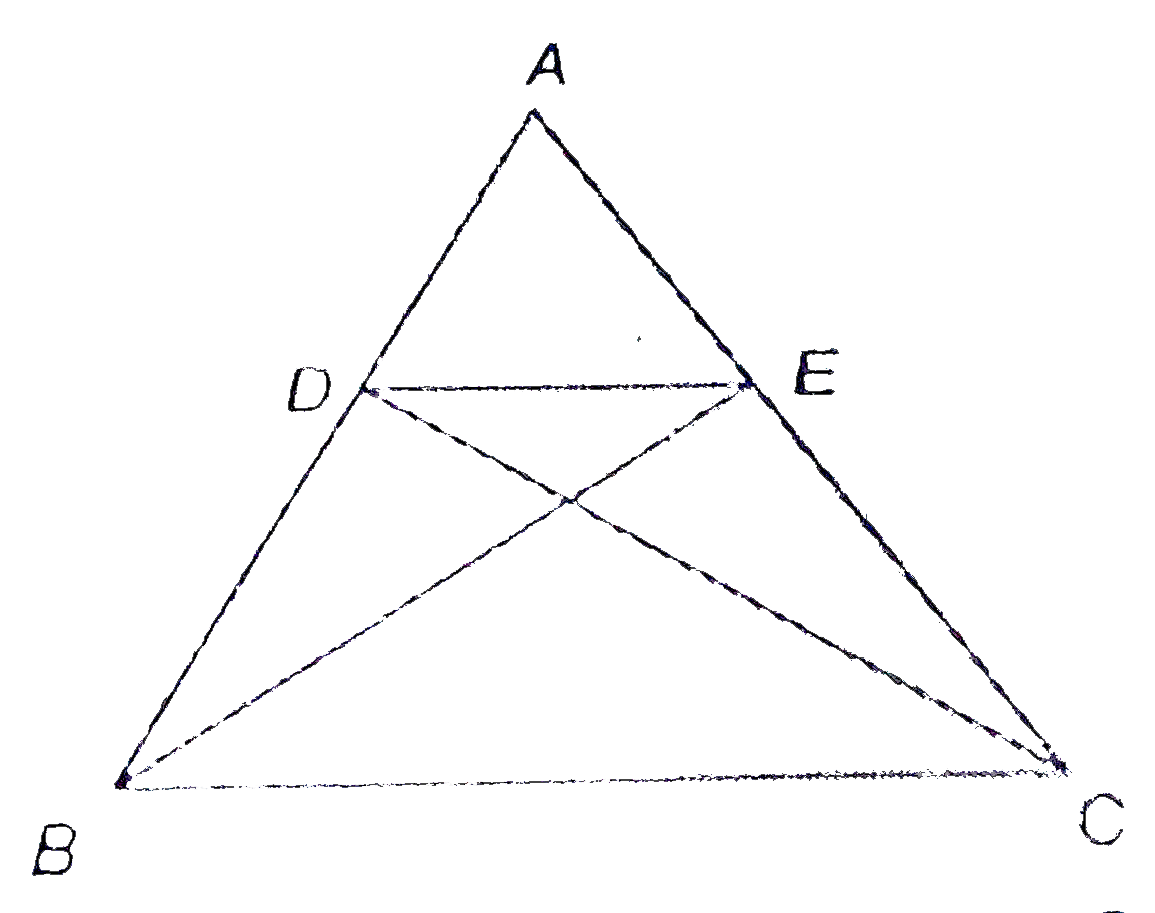ABCD is a square . Draw a triangle QBC on side BC considering BC as base and draw a triangle PAC on AC as its base such that ΔQBC~ΔPAC. Then, Area of ΔQBCArea of ΔPAC is equal to :
12
21
13
23
The correct Answer is:A
To solve the problem, we will follow these steps:
Step 1: Understand the Problem
We have a square ABCD, and we need to draw two triangles: QBC on side BC and PAC on diagonal AC, such that triangle QBC is similar to triangle PAC. We need to find the ratio of the areas of these triangles.
Step 2: Define the Square
Let the side length of the square ABCD be s. Thus, the coordinates of the square can be defined as:
- A(0, s)
- B(0, 0)
- C(s, 0)
- D(s, s)
Step 3: Identify the Bases of the Triangles
- For triangle QBC, the base is BC, which has a length of s.
- For triangle PAC, the base is AC, which is the diagonal of the square.
Step 4: Calculate the Length of AC
Using the Pythagorean theorem, we find the length of diagonal AC:
AC=√AB2+BC2=√s2+s2=√2s2=s√2
Step 5: Calculate the Areas of the Triangles
1. Area of Triangle QBC:
AreaQBC=12×base×height
Here, the base BC = s. Let the height from point Q to line BC be h1. Thus:
AreaQBC=12×s×h1
2. Area of Triangle PAC:
AreaPAC=12×base×height
Here, the base AC = s√2. Let the height from point P to line AC be h2. Thus:
AreaPAC=12×s√2×h2
Step 6: Use Similarity of Triangles
Since triangles QBC and PAC are similar, the ratio of their areas is equal to the square of the ratio of their corresponding sides. Thus:
AreaQBCAreaPAC=(ss√2)2=(1√2)2=12
Conclusion
The ratio of the area of triangle QBC to the area of triangle PAC is:
AreaQBCAreaPAC=12
We have a square ABCD, and we need to draw two triangles: QBC on side BC and PAC on diagonal AC, such that triangle QBC is similar to triangle PAC. We need to find the ratio of the areas of these triangles.
Let the side length of the square ABCD be s. Thus, the coordinates of the square can be defined as:
- A(0, s)
- B(0, 0)
- C(s, 0)
- D(s, s)
- For triangle QBC, the base is BC, which has a length of s.
- For triangle PAC, the base is AC, which is the diagonal of the square.
Using the Pythagorean theorem, we find the length of diagonal AC:
AC=√AB2+BC2=√s2+s2=√2s2=s√2
1. Area of Triangle QBC:
AreaQBC=12×base×height
Here, the base BC = s. Let the height from point Q to line BC be h1. Thus:
AreaQBC=12×s×h1
AreaPAC=12×base×height
Here, the base AC = s√2. Let the height from point P to line AC be h2. Thus:
AreaPAC=12×s√2×h2
Since triangles QBC and PAC are similar, the ratio of their areas is equal to the square of the ratio of their corresponding sides. Thus:
AreaQBCAreaPAC=(ss√2)2=(1√2)2=12
The ratio of the area of triangle QBC to the area of triangle PAC is:
AreaQBCAreaPAC=12
Topper's Solved these Questions
- MENSURATIONBOOK - KIRAN PUBLICATIONCHAPTER - MENSURATIONEXERCISE - TYPE - III
21 Videos
- MENSURATIONBOOK - KIRAN PUBLICATIONCHAPTER - MENSURATIONEXERCISE - TYPE - IV
169 Videos
- MENSURATIONBOOK - KIRAN PUBLICATIONCHAPTER - MENSURATIONEXERCISE - Test Yourself
28 Videos
- LCM AND HCF BOOK - KIRAN PUBLICATIONCHAPTER - LCM AND HCF EXERCISE - Test Yourself
18 Videos
- MISCELLANEOUSBOOK - KIRAN PUBLICATIONCHAPTER - MISCELLANEOUSEXERCISE - TYPE-VI
15 Videos
Similar Questions
Knowledge Check
ABCD is a square. Draw an equilateral triangle PBC on side BC considering BC is a base and an equilateral triangle QAC on diagonal AC considering AC is a base. Find the value of
Area of ΔPBCArea of ΔQAC.A12B1C13D14In ΔABC, P is a point on BC such that BP:PC=4:5 and Q is the mid - point of BP. Then area (ΔABQ) : area (ΔABC) is equal to :
A1:3B1:9C2:9D2:5The base of a triangle is 14 cm and its height is 8 cm. The area of the triangle is
A112cm2B56cm2C122cm2D66cm2
In the adjoning figure, D and E are the points on the sides AB and AC respectively of ΔABC and area of ΔBCE= area of ΔBCD.
Prove that DE∣∣BC

View SolutionConsider a square OABC ,If P and Q are the midpoints of sides AB and BC ,respectively. Then the value of 2(AreaofΔOPQ)Areaof□OABC is
View SolutionIn parallelogram ABCD, P is a point on side AB and Q is a point on side BC, prove that
(i) ΔCPDandΔAQD are equal in area.
(ii) area (ΔAQD)= area of ΔAPD+ area of ΔCPB
View SolutionΔABCandΔDBC are on same base BC and their vertices A and D are on opposite sides of BC. It is given that:
area of ΔABC= area of ΔDBC
Prove that BC bisects the line segment AD.
View SolutionΔABC is an equilateral triangle and D and E are midpoints of AB and BC respectively. Then the area of ΔABC : the area of the trapezium ADEC is
View Solution
